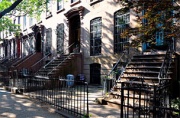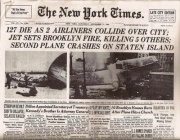Brooklyn Air DisasterFrom The Peopling of New York City
North Slope -- Setting the SceneWhere Sterling Place meets 6th Avenue in Brooklyn, neighborhoods collide and form a liminal space, which is almost a neighborhood of its own, where a landscape of old brownstones hide a rich history of demographic movement, and buildings erected and destroyed. Involved in creating the unique dynamic of this corner of Park Slope, there are more forces at work than I could possibly name, but I will focus on a key historical event, which played a significant role in making the neighborhood what it is today. Having lived on Sterling Place my whole life, the empty lot occupying the corner of Sterling and Seventh Avenue always intrigued me. It was filled with decades worth of garbage, and occasionally a car, and was contained by a chain-link fence topped with scraggly barbed wire. When I was really young, I never really questioned its presence. I have a hazy recollection of an old-timer from the block telling me that a plane had crashed there, but it never really concerned me. There was nothing to point out its significance. Getting older, I grew conscious of the potential value of the property and wondered how such an expensive piece of property could just be left to rot, and the creepy undertones of the "bit of bulldozed earth[1]" grew thicker. Now, understanding the disaster that occurred there, I wonder how I could possibly have spent my whole life a block away from one of the worst air disasters in history without knowing it. In addition to general curiosity regarding the disaster and its effect on the neighborhood, both in the abstract and physical senses, these questions will guide my project through the story of this lonely Park Slope street corner: Why did the lot remain empty for so long, and why did I never know about the crash? Below is a short video of the area as it appears today, starting on the corner of St. John's Place and Seventh Avenue, we continue down the block where the crash took place. The camera turns on the corner of Seventh Avenue and Sterling, where the empty lot, and before that the Pillar of Fire Church, once were, which is now occupied by a retro-looking condo building. Then we see St. Augustine's Church on the corner of Sixth Avenue, and stroll on down my native block, Sterling Place between Sixth and Fifth Avenues.
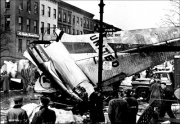 The wreckage immediately after the crash[2] The DisasterProbably the most astounding piece of history that I’ve uncovered about this block is the 1960 plane crash that took place on the corner of Sterling Place and Seventh Avenue. A United Airlines jet, flying from Chicago to New York International Airport, collided into a T.W.A. airliner heading east to LaGuardia. After puncturing the United jet, the airliner went on to crash in Staten Island. Meanwhile, the United Airlines jet split in two above Seventh Avenue. While the tail fell straight into the middle of the intersection at Seventh Avenue and Sterling Place, the nose and body of the plane skidded above the rooftops of Seventh Avenue's brownstones, which were (and are still) of uniform height, and then, approaching the irregularity of a church steeple, eventually plummeting into the Pillar of Fire Church. The gruesome scene pulled people from all over Brooklyn, such as “Mrs. Dorothy Fletcher, chief of the Brooklyn Volunteers for Civil Defense,” who “rushed from her home at 143 Berkeley Road,” and held a little boy, injured from the crash, the whole way to the hospital.[3]
Despite the heavy losses, very little remains to commemorate the disaster, and so it is being slowly forgotten by the community. I spend seventeen years of my life living a block away from the site and, short of a couple of second-hand accounts from the old-timers on the block, I never read or heard a word about it. The only reminder of this, what seems to be the greatest tragedy in the history of the neighborhood, is a bronze plaque hanging on a black wall in the chapel of New York Methodist Hospital, thirteen blocks south of the site itself. The plaque reads, “Our tribute to a boy brave little boy,” and from it hang the charred pennies that were found in his pocket.[5] 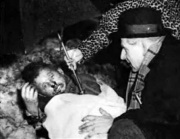 Stephen Baltz being pulled from a snowbank. Dorothy Fletcher holds the umbrella[6] Stephen BaltzThis plaque hangs in tribute to Stephen Baltz, the eleven-year-old who was found in a snow bank, his clothes aflame, on the corner of St. John’s Place and Seventh Avenue after having been thrown from the tail of the flaming airliner, which then landed in the middle of the intersection of Sterling Place and Seventh Avenue[7]. He was rescued by the aforementioned Dorothy Fletcher. He survived for 26 hours, and, for those 26 hours, was the only survivor of the crash. All of the United Airlines airliner’s one hundred and twenty eight passengers were killed, as well as eight on the ground[8]. Stephen Baltz was on his way to visit his Grandparents, Mr. and Mrs. William F. Snyder, at their home in Yonkers for Christmas and, as reported by the next day’s New York Times, “it was only by chance that the black-haired youngster was on the plane. He was to have flown here with his mother, Mrs. Phyllis Baltz, and his 9-year-old sister, Randee.”[9] The SceneA 10th grader at Saint Augustine’s School, on the corner of Sixth Avenue and Sterling Place, watched out the window of his study hall as the body of the plane soared into the Pillar of Fire Church, and the plane’s tail flew into the intersection of Sterling Place and Seventh Avenue. After evacuation, the school served as a “makeshift morgue” where the police and firemen could lay down the bodies that they pulled from the rubble[10]. Ray Garcia, in his book Sterling Place, gives a gripping first-hand account of the chaotic scene. On his way to look at some bicycles on Flatbush Avenue, somebody stopped 15-year-old Ray and warned him that a building had collapsed. “People thought a bomb had hit Sterling Place,” he says. He goes on to describe how the “thick black smoke” blinded everybody, heightening the state of panic and “pandemonium.” One of the most gruesome parts of his recollection is his account of the first body he encountered: “I had never seen death before, and, curious, I walked over to the body. It was a woman, wrapped around a fire hydrant. She hit the hydrant with such force that it was torn from its foundation. There was a puddle of blood in the snow, dripping from the side of her mouth.”[11]
In the margins are the following day's New York Times, which emphasizes the devastating impact of the DC-8 fall on Brooklyn as compared to the TWA Constellation, which fell on an unpopulated lot in Staten Island, killing only those inside of the plane; and a photograph of a church around the corner from the crash, which went relatively unharmed, but no longer stands there today. "’You look today and you can't believe the mayhem that happened on this corner,’ said Lt. James Bush, 80, one of the first firefighters to arrive at the scene. 'You couldn't see down the block for all the fire and smoke. We just started digging for bodies.'’' [13] 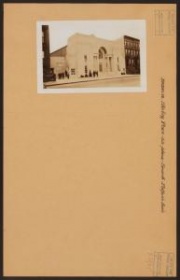 A church on Sterling Place between Flatbush and 7th Avenue[14] The Cooper family of 126 Sterling Place gave quite a graphic account. Their roof had been torn off when the body of the airliner skimmed across the top of several of the houses on the block. When the Red Cross workers came to rescue them, they saw a severed arm wearing a wristwatch laying at their front door. Below is a news report on the disaster.
Fred Holt, seven years old at the time, "lived around the corner when the neighborhood exploded in flames." He remembers it well, and it affected his life deeply. In fact, he's now a firefighter working out of Ladder Co. 229, which "responded to the fifth alarm that day." His memory is vivid as it is morbid: "'There was a guy selling Christmas trees on the corner. He got burnt alive . . . There were a couple of Sanitation workers picking up garbage that got killed too.'" He recalls going back the next day, saying poignantly that "It was like a dream."[15] Mary Boyle's recollection is equally clear. She lived, and still lives, in a brownstone on Sterling place, and was on the second floor when the plane came down. "'The windows in my house were smashed,'" she remembers, "'We had to get out of the house through the back and then we had to climb over fences.'" Mary's husband Andrew had to help their French tenant, then seven months pregnant, over the fence to make their escape through the backyards directly behind the houses that were directly hit by the plane.[16] The LotOne question that weighed heavily on my mind when approaching this project was how the empty lot on the corner of Sterling and Seventh Avenue, an extremely valuable piece of property on a commercial stretch, could have remained undeveloped for forty years after the accident. Dodson and Captain X pointed me towards an answer to this question as well. This corner was where the Pillar of Fire Church stood prior to the disaster. The nose of the United aircraft skidded over the rooftops of Seventh Avenue's brownstones, then plummeted directly into the church. Inside the church at the time was its caretaker, Wallace Lewis.[17] I believe that this has something to do with the failure to develop this lot, as well as irresponsibility on the part of the subsequent owners. The New York City Department of Buildings has records indicating new buildings, plumbing repairs, and the like dating back to 1969, as well as building violations dating equally far back, and appearing periodically up until the late 1990's.[18]
The Cover-UpInterestingly, one can pinpoint the individuals responsible for the disaster. As the United Airlines DC-8 airliner circled above New York, waiting to be cleared for landing, the TWA Constellation Flight 266’s Pilot Sawyer was in contact with the air-traffic controllers at LaGuardia airport, who were in contact with those at Idlewild (now Kennedy) Airport. When asked if they had any flights in the vicinity they said ‘no,’ when in fact the two were on a collision course, which was clear to whoever watched the radar at the LaGuardia tower when they saw that there was “one pinpoint where there had been two [19].” One Daily News staff writer went so far as to allot percentages of blame to the various parties, who weigh in at “1% for United, 24% for the U.S. government, representing the Federal Aviation Administration traffic controllers, and 15% for TWA, which agreed to share responsibility although its pilot had been following controllers' instructions.[20]” In financial terms, the costs of the lawsuits accrued exceed $300 million were divided with 61% of responsibility to United, 15% to TWA, and 24% to the US government[21], who also helped to relieve the financial burden of the subtly devious United Airlines[22]. Captain X, an anonymous ex-employee of United, and Reynolds Dodson, dig quite a bit deeper than aforementioned reporter, and place all of the blame on United and their political affiliates. They also point out that "good judgement dictated that the [United] crew notify air traffic control of its inoperative receiver so as to receive extra radar assistance," and that "United did not do this." However that was the least of United's offenses.[23] The bottom line is this: in order to save money, United Airlines "deprived the crewmembers of the legally required [safety] training." The crime itself is quite simple. What's amazing is the catastrophic disaster that it caused, and the fact that they got away with it. Apparently, through their "cozy relationship" with the FAA (Federal Aviation Agency), United managed to keep their outrageous lack of competency under wraps[24] Amazingly, the affiliation ran so deep, that FAA inspectors that gave honest reports, saying that the "United Airlines training program was dangerously unsatisfactory, that "weak crewmembers were denied corrective training," and that "United Airlines falsified air safety records to indicate training was given, when the training was not given" were literally fired or relocated. [25] In particular, Frank Harrell, gave a report explaining that United "denied the legally required training and check of [flight crew's] competency," two months prior to the crash. Not only did the report, which "explained why the DC-8 crew mishandled the aircraft as badly as they did," fail to surface in the NTSB's (National Transportation Safety Board's) investigation of the Brooklyn air disaster, but Harrell was removed from his position and transferred to an "undesirable assignment in Puerto Rico." Unexplainable. Unexplainable, at least, until one finds that the U.S. government itself was tied into the conspiracy. According to Captain X and Reynolds Dodson, the parties "obstructing compliance with air safety laws" included "members of congress."[26] Another attempt to put a stop to the laziness and frugality that endangered countless lives took place only two days before the crash, when Air Force General E.R. Quesada, the "head of the Federal Aviation Agency," accused ALPA (Air Line Pilots Association) and the AOPA (Aircraft Owners and Pilots Association) of "interfering with aviation safety." Despite his anomalous honesty, his claim was quickly shut down by corrupt officials, and removed from his position as head of the FAA.[27] Chairman of the Senate Aviation Subcommittee, Senator Mike Monroney of Oklahoma, a "recipient of campaign funds" from both the ALPA and AOPA, condemned Quesada and, "under the direction and insistence of Attorney General Robert Kennedy," decided to "relieve United of considerable financial responsibility for the crash.[28] Despite all the warnings, this year, 1960, was a record year for deaths in aircraft disasters. The total death toll was more than 2,100 people.[29] Below is a news report emphasizing the abundance of air disasters in that week. Following the crashes in Brooklyn and Staten Island, there was an air disaster in Munich, Germany. Clearly lack of airline safety was being ignored as a leading cause of death.
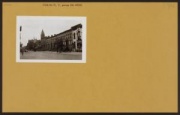 7th Avenue between Sterling and St. Johns Place[30] A Neighborhood and its HistoryFred Holt, the fireman who noted the death of the Christmas tree salesman, experiences continuing frustration regarding the community's lack of commemoration for this disaster, whose death toll was 134. Fred attended a anniversary memorial service for the crash and was upset to see that the attendance reached only ten people. "'At the corner I saw two people,'" he recalls, "'I guess they call them yuppies. And they're living here and the couldn't tell me what happened."[31] This is a continuing aspect of life in this neighborhood: the expanding "yuppie" population butting up against the territory of the unmoving, old-school working class. The relationship is a dynamic one, and dictates a lot about the neighborhood both geographically and socially. Stores specializing in high-end baby clothes commonly open a storefront where a long-time neighborhood business once stood, that simply could no longer make rent. Young women with strollers occupy the sidewalk, blocking the path of the old-timer with his unwieldy walker. Houses are constantly being turned over from old neighborhood characters to young, hip computer programmers and businessmen. Having completed this project, I see my home neighborhood with new clarity and depth. I see through the buildings, into their stories, and into the lives that have began there, such as mine, and ended there, such as those on United's DC-8 jet. The accident is of a magnitude that deserves some sort of a monument at the least. But having found a government conspiracy determined to keep a low-profile surrounding the accident, it is no wonder that I grew up without hearing of it. Though there is a touch of mystery remaining in my concept of why the lot could have remained "a bit of bulldozed earth" [32] for nearly my entire life and the thirty years leading up to it, there is a sense of understanding, of feeling that I know my home for what it really is, rather than for what people tell me (or don't tell me) or it is. When I went to the Brooklyn Public Library's Brooklyn Collection, I was surprised with the apparent lack of interest in my topic. I went to the desk and asked if they had a file on the air disaster that had taken place around the corner. The woman sitting behind the desk thought for a moment and then, with a turn of the head so as to say "Oh that old thing," got up and said to me, "I think we have something." The file she brought me was packed with a wealth of information that, seemingly, nobody had looked at in quite a while. The air disaster left behind an ocean of eery undercurrents swimming below the history of this peaceful, upscale neighborhood. Nathaniel Altman, a reporter for the Park Slope Reader points out that "at the time the area around Sterling Place and Seventh Avenue was called 'a neighborhood in transition.'" [33] It seems that the plane crash may have frozen the neighborhood in its place, constantly in flux, straddling the extreme upper class and the struggling middle-class. Perhaps one could now better describe it as a neighborhood of transition. Altman describes that "middle-income families were moving out" at the time of the crash, and I see that as a continuing process. In my experience living on Sterling Place, my friends and our parents, probably some of the less affluent in our neighborhood, were constantly threatened by increasing rent prices, and our group slimmed out substantially as years passed. The area holds a liminal space between the upscale shopping of Seventh Avenue and the more rugged, industrial scene of the Atlantic Mall, and undergoes a continual process of gentrification that doesn't really seem to carry it anywhere, except a continuing state of change. Anything of this magnitude will have its effect on the fabric of a neighborhood. The community was really forced to band together in the face of a crisis, and in doing so, this little corner of Park Slope has become a neighborhood of its own, constantly in flux. 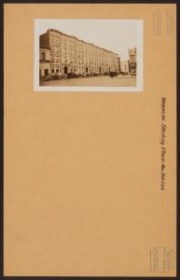 6th Ave between Sterling and St Johns Place[34]
[[Image:|Index-3.jpg|thumb|[35]]]
References
|

